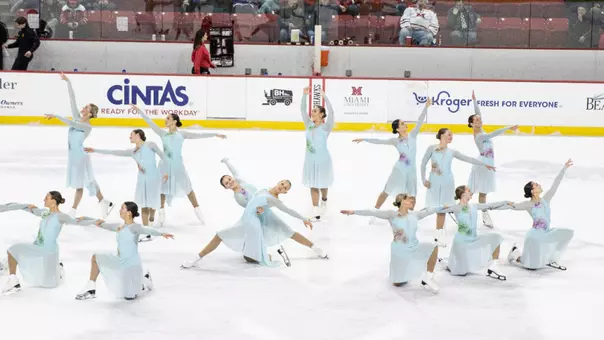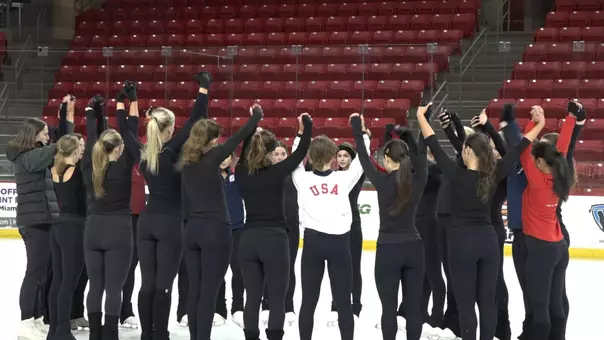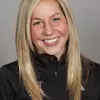Skating Trio Takes on Mt. Everest
8/2/2011 12:00:00 AM | Synchronized Skating
Aug. 2, 2011
By Drew Davis

|
This summer, the Midwest has been hit with an unrelenting heat-wave with temperatures reaching more than 100 degrees. The air has been hot, humid and thick, but three Miami University synchronized skaters - Martha Buckley, Courtney Voss and Kerrie Wilcox - beat the heat by taking advantage of a university study-abroad program to travel where the air was cool, dry and thin at the base of the tallest mountain in the world.
Buckley, Wilcox and Voss travelled with a group of nine other Miami students, led by kinesiology professor Dr. Mark Walsh, to Nepal to travel to the base camp of Mt. Everest to immerse themselves in a culture far removed from the western world and to test the limits of their endurance at altitudes that limited oxygen intake at one of the most recognizable features on Earth.
The trip was organized through three different departments at Miami - kinesiology, sociology and Asian studies. Students who went on the trip received five credit hours in their choice of the three subjects for their learning experience with the cultural and physiological side of the trip.
"I had Dr. Walsh for biomechanics and he introduced the trip the first week of class," Voss said. "I had seen posters about it since I was a freshman, but I never thought I would do it. After talking to Dr. Walsh and some people who had gone on the trip before, I saw it as a unique opportunity that I may never get another chance to do."
Voss immediately started talking to her teammates about the trip after deciding to go. Buckley and Wilcox soon realized they too wanted to take advantage of the opportunity.
"I was thinking about a trip abroad to somewhere in Europe when Courtney brought it up and told me to check it out," Buckley said. "I had a neighbor who had climbed Everest, so I had a little bit of a personal connection and I've been interested in Asian cultures for a long time. I liked the challenge it posed and decided to do it."
"I first heard about it from Courtney and then in my biomechanics course from Dr. Walsh," Wilcox said. "Once I found out Martha was going too, I constantly heard her and Courtney talking about how awesome the trip was going to be, so I finally asked my parents if I could go on this experience of a lifetime."
Joining them on the trip were two sociology professors, some Nepalese friends of one of the professors, who is a native of the country, and five Sherpas to guide them in the mountains, bringing the total to 25 people.
In all, the students spent 28 days abroad, including 14 days trekking in the mountains. They traveled first to Hong Kong for a day tour of the city during a 12-hour layover before flying to Kathmandu, the capital of Nepal.
"The next day we flew into Lukla," Wilcox said. There, they landed "on one of the world's top-five most-dangerous runways."
Buckley recounted the landing as a memorable part of the trip: "The runway is actually built into the mountain," she said. "It looks like you are going to go right into it as you land."
Safely on the ground, they started their trek, traveling to nine different villages where they stayed for up to two nights to adjust to the altitude and learn about the local lifestyles.
"The culture there is so unique," Voss said. "The people there are so proud and willing to show you and let you experience their culture. There was no conflict and everyone was very open with sharing their lifestyle."
"Something that I thought was so impressive was everyone's attitudes toward life," Buckley said. "The Sherpas, the people we saw on the trip and the sociology professor's friends; everyone was so positive all the time and focused on living in the moment, living each day to the fullest."
"The people were so warm and welcoming," Wilcox added. "The Sherpas would do anything to help you out and always had a smile on their faces. Going there made me realize how much we take for granted."

|
All three skaters said the day trek to Kala Patthar, the highest altitude they reached and a point that is-at over 18,000 feet above sea level-higher than any peak in North America besides Mt. McKinley, was one of the most memorable experiences of the trip.
"We got up at 4 a.m. and watched the sunrise," Voss said. "Then we hiked for four hours before stopping for breakfast. After that we trekked another two hours almost straight up until we got to the top. Once we made it, we had an amazing view of the peak of Everest. Snow was blowing off the top of the mountain and there wasn't a cloud in the sky."
Buckley and Wilcox agreed the difficult hike up was well worth the reward at the top.
"I had read about Everest and the view at Kala Patthar. I had seen pictures and movies," Buckley said. "You think you know what it will look like, but when you get there it is just ââ'¬Â¦ breathtaking."
"We had a great view of Everest and base camp," Wilcox said. "Once we got to the top we spent a lot of time taking pictures and celebrating all of us making it there. This was the largest group Miami had ever taken on this trip and the first time everyone made it all the way."
Trekking through Renjo La Pass was another favorite day for the trio. It marked the first time a group from Miami had taken that route and all three were proud to have taken part.
"Only a few of our Sherpas had even completed the pass before," Wilcox said. "We didn't get to the top before clouds covered up Everest, but the view was still unlike anything I have ever seen. Everywhere you looked there were snow-capped mountains. We could see part of Everest, but a cloud covered the peak. It took us six hours to get to the top of the pass and the last hour and a half was all through snow. You would take one step and slide down two. It was a very physically-challenging day, but once I got to the top, I had never felt so proud and accomplished."
Buckley said having her teammates along with her helped make the more challenging portions of the trip possible.
"It was awesome to share the experience with two of my teammates," she said. "When we were going through some of the harder passes, we were able to support each other in ways other people may not have been able to. We know each other so well from training together at Miami that we can tell when one of us is struggling and know how to push and encourage each other. I supported them and they supported me."
The physically-strenuous trip at such high altitudes had a noticeable effect on them and each took particular notice as they got back to lower altitudes at the end of trip.
"The altitude change was so drastic," Voss said. "We took a lot of breaks and drank a lot of water while we were trekking. It was humbling as an athlete. I knew it would be hard, but didn't realize just how hard. But when I got back home I went for a run, and I'm not a real big runner, but I thought it was a piece of cake. It was so much easier to breathe."
"It was interesting to notice the differences in the altitude," Buckley said. "I noticed it more when we were descending. Our pace on the way back down was so much faster than the way up as our body's acclimated."







